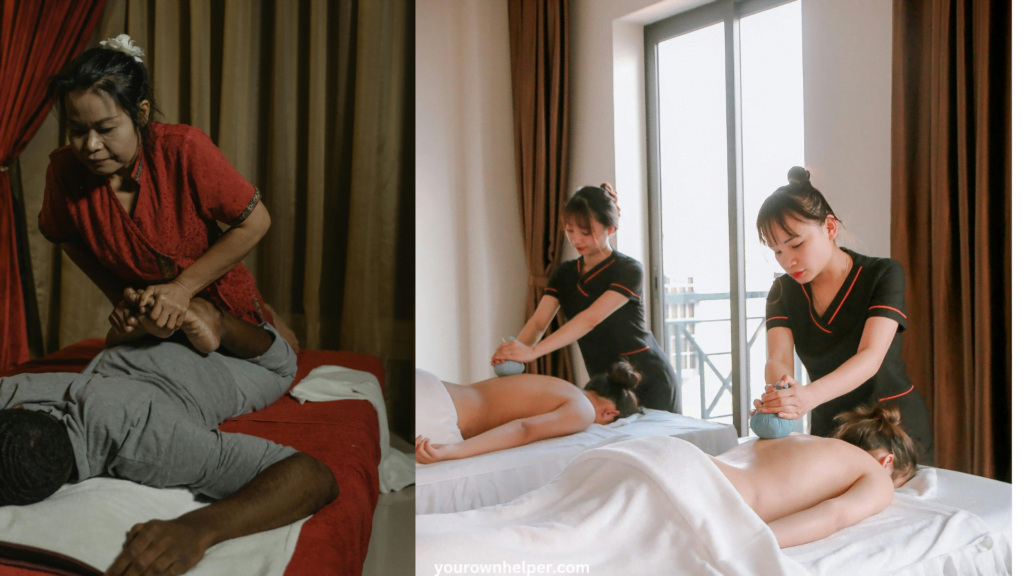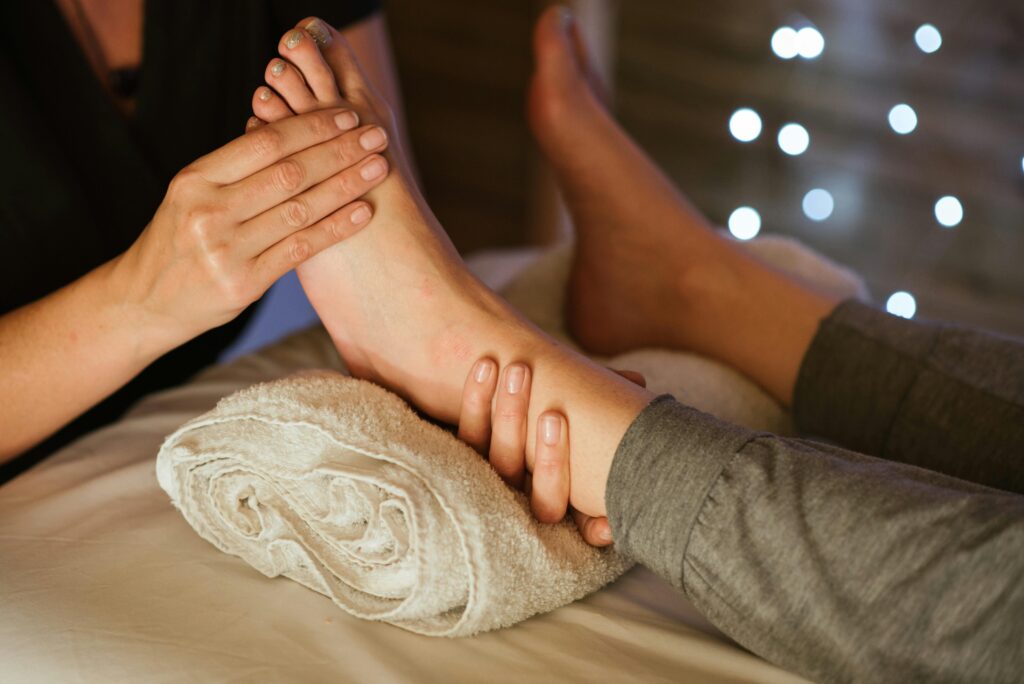
You’ve probably heard a lot about Thai massage and its various benefits. Maybe you’re just curious, or you want to start collecting them yourself. Either way, you’ve come to the correct place. This guide will teach you everything you need to know to become a master in the ancient healing art of Thai massage. You will learn about its history, procedures, benefits, contraindications, and more. We’ll even answer some frequently asked concerns to help you feel prepared and confident before your first Thai massage appointment. This detailed guide will help you develop a better knowledge and appreciation for this particular type of therapy. So prepare to immerse yourself in the lovely world of Thai massage.
Table of Contents
What Is Authentic Thai Massage?
Thai massage is an ancient healing art that combines acupressure, Indian Ayurvedic principles, and assisted yoga postures. During a Thai massage, the therapist uses their hands, knees, legs, and feet to move you into a series of yoga-like stretches. Muscle compression, joint mobilization, and acupressure are also used.
It’s not just a massage
Thai massage is more energizing than other forms of massage. It’s a dynamic meditation for your body and mind. The therapist guides you through a sequence of postures designed to increase flexibility, relieve muscle and joint tension, and balance your body’s energy flow.
How does it work?
Thai massage works the entire body using a variety of techniques:Yoga-like stretches keep joints flexible and muscles long and strong.Pressure point massage activates energy lines called sen. Releasing blockages inthese lines restores balance and health.Muscle rolling and compression relieve tension and spasms.Mobilizing joints keeps them flexible and mobile.
What to expect?
A typical Thai massage lasts 60 to 90 minutes. No oils are used, so you remain clothed. The massage is performed on a padded mat on the floor. The therapist will guide you. through gentle yoga-like movements and stretches. You may experience temporary soreness for 1-2 days after a treatment. Always tell your therapist about any injuries or sensitive areas before starting.Thai massage provides many benefits when performed by a skilled therapist. However, it may exacerbate injuries if not done properly.
As with any massage, if you experience discomfort during the session, tell your therapist immediately. While rare, side effects can Include muscle strains, sprains, and nerve damage. As with any therapy, you should consult your doctor first if you have a medical condition.
The History and Origins of Thai Massage
Thai massage has a long and rich history spanning over 2,500 years. Around 500 BC, a man known as Shivago Komarpaj is said to have founded Thai massage after he was Inspired and influenced by Indian healing practices. As Buddhism spread to Thailand, Thai massage became closely associated with spiritual and meditative practices.
The Spread of Thai Massage
In the 19th century, Thai massage gained popularity and recognition. King Rama III ordered that it be taught in the first Thai massage school established in Wat Pho temple. in Bangkok. Since then, Thal massage has become popular all over the world.
The Philosophical Influences
Thai massage is based on the concept that energy flows through the body and provides a balance between the body and mind. Several philosophies have influenced Thai massage, including Ayurveda and traditional Chinese medicine. The goal of Thai massage is to restore the flow of energy and life force throughout the body.
The Techniques
Thai massage uses gentle pressure and stretching techniques to relax the muscles and tendons. Practitioners use their hands, elbows, knees and feet to compress and stretch the body. The massage generally follows the energy lines of the body. Common techniques include palming, thumbing, kneeling, and arching. Oil is typically not used in Thai massage.Thai massage provides many benefits, though it may lead to minor side effects for some.
Be sure to consult your doctor before booking an appointment. With the proper precautions taken, Thai massage can be a safe and therapeutic experience for people of all fitness levels.
The Benefits of Authentic Thai Massage

Relieves Stress and Tension
Thai massage is designed to relax the entire body. It uses gentle pressure and stretching techniques to relieve stress and tension. The long, kneading strokes help loosen tight muscles and Joints. The stretching poses help Increase flexibility and range of motion. Many people find Thai massage blissfully relaxing.
Improves Flexibility and Range of Motion
Thai massage Incorporates many yoga-like stretches that help loosen the joints and increase flexibility. The therapist will gently move and stretch your body into different poses. hip openers, backbends, and hamstring stretches. Regular Thai massage therapy can help improve your flexibility and range of motion over time.
Relieves Pain
Thai massage can help relieve muscle pain and spasms. The massage therapist applies pressure to energy lines and pressure points throughout the body to release blocked energy and relieve pain. Thai massage may help reduce pain from conditions like sciatica, stiff neck, and lower back pain. It can also help relieve tension headaches and migraines.
Boosts Energy Flow
Thai massage is based on the concept of Invisible energy lines that run throughout the body. The massage is designed to unblock and balance the flow of energy through these Iines. When energy flows freely through the body, It promotes health and vitality. Many people report feeling energized and revitalized after a Thai massage session.
Precautions to Take Before Getting a Thai Massage
Before getting a traditional Thai massage, there are a few precautions you should keep in mind.For some people, the techniques used in Thai massage may be too intense. The massage Involves deep compression and stretching. If you have any injuries, chronic pain, or limited mobility, be sure to let your massage therapist know before starting the massage. They can adjust the techniques to your level of comfort and flexibility.
Check with your doctor
If you have any medical conditions like blood clots, fractures, or chronic illnesses, check with your doctor first before getting a Thai massage. The deep tissue manipulation and stretching can exacerbate some conditions. Pregnant women should also get clearance from their doctor before proceeding with a Thai massage.
Come on an empty stomach
Give yourself at least 2 hours after eating before getting a Thai massage. The massage techniques can sometimes cause discomfort if you’ve just eaten. An empty stomach is best for maximum comfort and relaxation.
Dress comfortably
Wear loose and comfortable clothing that allows free movement. Shorts and a t-shirt or tank top are Ideal. Remove belts, watches, and any other accessories before starting your massage.
Be well hydrated
Drink plenty of water before and after your Thai massage. The techniques used can release metabolic waste and toxins from your muscles and tissues. Staying hydrated will help flush these from your body.
Expect some soreness
Thai massage uses deep compression and stretching. Even when done properly by a skilled therapist, you may feel some soreness for a couple of days after your treatment. Apply ice, take an over-the-counter pain reliever if needed, and be gentle with yourself as your body adjusts. The soreness should subside quickly, but the benefits of increased flexibility and range of motion can last for weeks.
With some precautions taken, an authentic Thai massage can be a very therapeutic and rejuvenating experience. Be sure to communicate with your therapist and take care of yourself afterwards. The rewards of this ancient healing art can be well worth it.
Side Effects and Risks of Thai Massage

Thai massage is generally very safe for most people when performed by a trained and certified therapist. However, as with any massage therapy, there are some side effects and risks to be aware of.
Muscle Soreness
It’s common to feel some muscle soreness for 1-2 days after a Thai massage. The stretching and pressure techniques can cause minor muscle strains or tears, leading to tenderness. Applying ice, heat, and over-the-counter pain relievers can help relieve this discomfort. The soreness should subside within a couple of days. See a doctor if the pain. is severe or lasts longer.
Bruising
The pressure and stretching in Thai massage may cause minor bruising, especially in people with sensitive skin or who bruise easily. Bruises will usually clear up within 1-2 weeks. Talk to your therapist about modifying techniques to be gentler if you’re prone to bruising.
Joint Dislocation
While rare, forceful stretching could potentially dislocate joints, especially in people with hypermobility or joint conditions like osteoarthritis. Inform your therapist about any joint concerns you have so they can properly support those areas during the massage. Seek medical help immediately if you experience a joint dislocation.
Allergic Reaction
Some people may have an allergic reaction to the massage olls or lotions used. Test a small patch of skin first or request an alternative hypoallergenic product. Get medical assistance right away If you experience symptoms like Itching, rash, swelling or shortness of breath.
Underlying Conditions
Massage may be unsafe for people with certain medical issues like blood clots, injuries or fractures. Check with your doctor first if you have any serious or chronic conditions. Your therapist should also evaluate your health history to determine if Thai massage is appropriate and make any necessary modifications.While Thai massage provides many benefits when done properly, you should be aware of these potential side effects and risks. Talk to your therapist about any concerns you have, and see a doctor if you experience severe or prolonged pain, discomfort or other Issues following a massage session.
Some best Authentic Thai Massage in NYC
Finding the best authentic Thai massage in NYC is subjective, as it is determined by personal preferences and experiences. Here are some renowned locations that offer real Thai massage treatments in New York City:
Thai Massage NYC by Fern Thai: This Midtown Manhattan facility is well-known for its competent therapists and traditional Thai massage techniques.
Thai Massage Midtown: This institution, located in the center of Midtown, provides a variety of Thai massage services, including traditional Thai massage, Thai herbal ball massage, and more.
Yelp’s Top Thai Massage Spas: Check Yelp for top-rated Thai massage spas in NYC, where you can read customer reviews and make an informed decision.
Thai Wellness Massage: This Queens establishment is well-known for its authentic Thai massage therapies, which are performed by experienced practitioners.
Thai Body Kinetics: Located in Brooklyn, this facility provides a variety of Thai massage treatments that emphasize traditional techniques and therapeutic advantages.
Before making an appointment, research each business, read reviews, and call them personally to learn about their services, therapist qualifications, and price. For your peace of mind, be sure the spa adheres to proper cleanliness and safety regulations.
FAQs:About Authentic Thai Massage
Do I have to be completely undressed for a Thai massage?
No, you do not need to be completely undressed for a Thai massage. You will be provided loose and comfortable clothing to change into. Only the areas of your body that are being massaged will be exposed. Your privacy and comfort are important to the massage therapist.
Will a Thai massage hurt?
A Thai massage can be quite firm, but should not hurt. The massage therapist will ask for feedback on the pressure during your massage and will adjust as needed. Some minor soreness after a Thai massage Is normal, but you should never feel intense or sharp pain. Always communicate with your massage therapist if you feel pain so they can make adjustments.
How often should I get a Thai massage?
The frequency of Thai massages depends on your needs and goals. For general relaxation and stress relief, a monthly or biweekly massage is common. If you have chronic pain or specific muscle issues you want to address, you may need more frequent massages, such as weekly or twice monthly. It is best to consult with your massage therapist for a recommendation based on your unique situation.
Is Thai massage painful?
Thai massage uses firm pressure, but should not be painful. Be sure to communicate with your therapist if you feel discomfort at any time. They can adjust the pressure to your comfort level.
What should I wear for a Thai massage?
Loose, comfortable clothing that allows for movement. Thai massage is traditionally performed on a mat on the floor, so flexibility and range of motion are important. Yoga or exercise clothes are Ideal.
How often should I get a Thai massage?
For general health and wellness benefits, a 60 to 90 minute Thai massage 1-2 times per month is recommended. For chronic pain or conditions, weekly or biweekly treatments may be helpful. Always check with your doctor for guidance specific to your situation.
Conclusion
So that’s all you need to know about authentic Thai massage! Now that you have a thorough grasp of this ancient practice, from its origins and procedures to its advantages and risks, you can determine whether it is something you want to attempt. With a professional Thai massage practitioner, you’ll leave feeling rested and invigorated. If you have any further questions, please refer back to the FAQ. Hopefully, this article provided a thorough explanation of this distinct massage style. Give it a shot the next time your muscles want some TLC.If you want to learn more about it check its Wikipedia page.Thank you.
